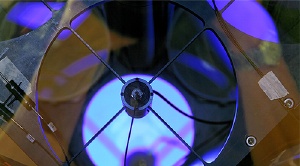Aug 26 2008
On August 26, EPFL, the Swiss National Science Foundation and Switzerland's National Weather service, MeteoSwiss, will inaugurate a new LIDAR measurement system in Payerne, Switzerland. This technically innovative installation, unique in the world, will provide continuous data on atmospheric humidity for Western Switzerland's weather forecasting headquarters.
 Part of the new LIDAR system installed in Western Switzerland's weather forecasting headquarters
Part of the new LIDAR system installed in Western Switzerland's weather forecasting headquarters
To make accurate forecasts, meteorologists need data on the vertical distribution of temperature and humidity in the atmosphere. The LIDAR system developed by EPFL can collect these data continuously and automatically up to an altitude of 10km. On August 26, EPFL will officially transfer this custom-developed LIDAR to MeteoSwiss, and from this point on Swiss forecasters will have access to this source of vertical humidity data for the models they use to calculate weather predictions. The project was supported by funding from the Swiss National Science Foundation.
One-of-a-kind Swiss know-how
The LIDAR system developed by EPFL is a relative of the familiar RADAR systems used widely in weather forecasting. Instead of sending radio waves out looking for water droplets, however, the LIDAR sends a beam of light vertically into the sky. The "echo" here is a reflection of that light from different layers in the atmosphere. This reflection is used to build an instantaneous vertical profile of temperature and humidity. The spatial and temporal resolution is excellent – the laser beam can be shot 30 times per second, a vast improvement over weather balloons that take minutes to reach the upper atmosphere and can be sent out only a few times a day. And even though it's state-of-the-art technology, the LIDAR developed by EPFL is stable and reliable; even after a test run of several months, it did not need tuning. Traditional LIDAR systems are more finicky, typically needing to be tuned on a daily basis. According to project leader and EPFL Professor Hubert van den Bergh, "This LIDAR will serve as a reference for future or existing systems, especially since this kind of remote sensing is experiencing rapid development."
An ideal complement to MeteoSwiss' forecasting toolkit
The new LIDAR will operate at the Center for Technical Measurements at MeteoSwiss' Payerne weather service. It will provide an ideal complement to the traditional instrumentation already in place: a ground-based measurement network, balloon launched radio-soundings, radar equipment, remotely sensed windspeed and temperature measurements, and a station of the Baseline Surface Radiation Network, part of a world-wide network that measures radiation changes at the Earth's surface. The combination of all these measurements will open up new possibilities, and weather forecasting models stand to benefit. The acquisition of the LIDAR will bring high-resolution three-dimensional humidity data to Swiss weather forecasting for the first time.